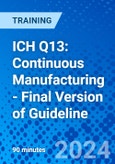The ICH Q13 guideline encompasses a comprehensive exploration of both scientific and regulatory facets concerning the development, implementation, operational aspects, and the entire life cycle management of continuous manufacturing processes.
Continuous manufacturing, in this context, signifies a dynamic process that involves the uninterrupted flow of raw materials into the manufacturing process, their conversion within the process, and the simultaneous extraction of the final product. While this concept is applicable across various processes such as tableting and chromatography, our focus here is on the integrated approach, specifically the amalgamation of multiple unit operations. Within this continuous framework, any alterations or fluctuations occurring in downstream processes are adeptly controlled in real-time by the corresponding upstream processes. Additionally, this continuous paradigm naturally generates batches, which can be characterized not only by the quantities employed but also by the duration of the process.
WHY YOU SHOULD ATTEND:
1. Broad Applicability:
The ICH Q13 Guideline can be seamlessly applied to the manufacturing of active pharmaceutical ingredients and medicinal products, encompassing both small and large molecules. This guideline is equally relevant to a spectrum of scenarios, ranging from the development of new products, including new drugs, generics, and biosimilars, to the transformation of traditional batch production into a continuous production model for existing products. It delves into critical facets of development, Good Manufacturing Practices (GMP), and regulatory affairs.2. Comprehensive Structure:
Similar to the draft version, the final release of the guideline is structured into two distinct parts. Part 1 primarily focuses on regulatory considerations and provides essential definitions that serve as the foundation for understanding the principles at play. Part 2, which holds particular intrigue, comprises five informative annexes, each honing in on the continuous manufacturing of the following:- Active ingredients
- Medicinal products
- Therapeutic proteins
- Integrated manufacturing of APIs and drugs
- Strategies for handling process disturbances
Course Content
- Introduction - Challenges of 21st Century Pharmaceutical Manufacturing
- Discussion of ICH Q13 contents
- Advantages of Continuous Manufacturing
- First Steps toward Continuous Pharmaceutical Manufacturing
- Recent Progress in Continuous Pharmaceutical Technologies
Speakers
Kelly ThomasMs. Thomas has over two decades of cGMP hands-on industry experience in both pharmaceutical and medical device manufacturing operations. Her experience covers all Quality Systems; as well as, all areas of validation; including, process/product validation, facilities validation, CSV and 21 CFR Part 11, test method validation, equipment/automated processes and cleaning validation.
Utilizing strategic thinking, risk based approaches, and Lean principles, she has demonstrated success in steering and managing complex projects within the pharmaceutical and medical device industries.
Who Should Attend
- Quality Assurance Departments
- Quality Control Departments
- Regulatory Affairs Departments
- Research and Development Departments
- Manufacturing Departments
- Production Departments
- Engineering Departments
- Operations Departments
- Product Development Professionals
- Process Engineers
- Compliance Departments
- Validation Departments
- Top Management








